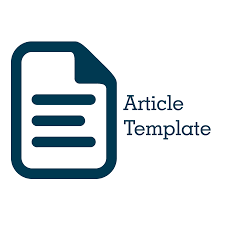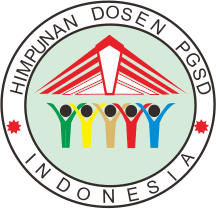Analisis problem-solving skills IPAS materi perubahan wujud benda pada peserta didik kelas IV sekolah dasar
Abstract
This study aims to analyze the problem-solving skills of fourth-grade elementary school students in understanding changes in the state of objects. The study was conducted at SDN Dukuhan Kerten using a quantitative survey method, involving 26 students. The instrument used was a descriptive test with three questions covering the concepts of melting and freezing, evaporating and condensing, and sublimating and crystallizing. The results of the analysis showed that students had difficulties, especially in planning and implementing solutions. In question number 1 (melting and freezing), the greatest difficulty lies in planning problem solving, with a percentage of conceptual understanding of 73%. In question number 2 (evaporating and condensing), the main difficulty is implementing the plan, although the percentage of indicator achievement is the highest (61.8%). In question number 3 (subliming and crystallizing), conceptual errors and implementing the plan are the biggest challenges, although problem evaluation shows the highest achievement (56.4%). Theoretical implications show the importance of teaching that combines conceptual understanding with high-level cognitive skills, while practical implications require educators to strengthen planning and implementing solutions in learning and integrate real-life situations and evaluation of problem-solving as an integral part of the learning process.
Keywords
Full Text:
PDFReferences
D. H. Jonassen, “Toward a Design Theory of Problem Solving,” Educational Technology Research and Development, 48(4), pp. 63–85, 2000.
F. Korkut, “Problem Solving Skills of High School Students,” Hacettepe University Faculty of Education Journal, 22(1), pp. 177–184, 2002.
E. Yuni, W. ; Dwi, A. Sudjimat, and A. Nyoto, “Transformasi Pendidikan Abad 21 sebagai Tuntutan Pengembangan Sumber Daya Manusia di Era Global,” in Prosiding Seminar Nasional Pendidikan Matematika 2016, Malang: Universitas Kanjuruhan Malang, 2016, pp. 263–278.
A. Anjarwati, I. Setyawati, N. A. Wijaya, R. Sholeha, and S. D. M. Putri, “Meningkatkan Pengetahuan Peserta Didik Mengenai Perubahan Wujud Benda Pada Mata Pelajaran IPA,” Jurnal Pendidikan, Sains Dan Teknologi, 1(1), pp. 60–66, 2022.
D. E. N. Cahyaningrum and A. Rosyid, “Peningkatan Hasil Belajar IPA pada Materi Perubahan Wujud Benda melalui Penerapan Metode Mind Mapping,” Pendidikan dasar: Jurnal Ilmiah Pendidikan Dasar, 8(3), pp. 6855–6863, 2023.
R. R. Wandini, C. Bariyah, H. A. Lubis, N. M. Nur, and S. Mardhatillah, “Metode Eksperimen pada Proses Pembelajaran Perubahan Wujud Benda pada Sekolah Dasar,” Jurnal Pendidikan dan Konseling (JPDK), 4(3), pp. 2014–2020, 2022.
W. Sulikah, A. Setyawan, and T. Citrawati, “Identifikasi Hasil Belajar Siswa Muatan IPA Materi Perubahan Wujud Benda Kelas V SDN Socah 4,” Prosiding Nasional Pendidikan: LPPM IKIP PGRI Bojonegoro, 1(1), 2020.
Y. Safitri, “Pengaruh Penerapan Metode Problem Solving terhadap Hasil Belajar Matematika Siswa Kelas IV SD Negeri 10,” Universitas Lampung, Bandar Lampung, 2016. Accessed: May 26, 2024. [Online]. Available: https://digilib.unila.ac.id/22340/
J. Butterworth and G. Thwaites, Thinking Skills: Critical Thinking and Problem Solving, 2nd ed. Cambridge: Cambridge University Press, 2013. Accessed: Jun. 03, 2024. [Online]. Available: : www.cambridge.org/9781107606302
M. Eskin, Problem Solving Therapy in the Clinical Practice, 1st ed. London: Elsevier, 2013. doi: 10.1016/b978-0-12-398455-5.00001-2.
R. E. Mayer, “Cognitive, Metacognitive, and Motivational Aspects of Problem Solving,” Instructional Science, 26, Netherland, pp. 49–63, 1998.
M. Widiawati, S. Istiyati, and A. Surya, “Penerapan model pembelajaran creative problem solving untuk meningkatkan keterampilan pemecahan masalah pada soal cerita bangun ruang peserta didik kelas V sekolah dasar,” Didaktika Dwija Indria, 7(1), pp. 1–6, 2019.
S. P. Utama, S. Marmoah, and M. Matsuri, “Penerapan model pembelajaran think talk write (ttw) untuk meningkatkan keterampilan pemecahan masalah interpretasi data peserta didik kelas v sekolah dasar,” Didaktika Dwija Indria, 7(5), pp. 7–12, 2019.
M. Zayyadi and W. H. Maulana, “Profil Berpikir Siswa Sekolah Menengah Kejuruan dalam Memecahkan Masalah Matematika Ditinjau dari Gender,” in Prosiding Seminar Nasional Pendidikan Matematika, 2016.
L. Darsani, “Penerapan model pembelajaran berbasis masalah untuk meningkatkan hasil belajar ipa,” Jurnal Pedagogi Dan Pembelajaran, 2(3), pp. 377–385, 2019.
R. R. Wandini, C. Bariyah, H. A. Lubis, N. M. Nur, and S. Mardhatillah, “Metode Eksperimen pada Proses Pembelajaran Perubahan Wujud Benda pada Sekolah Dasar,” Jurnal Pendidikan dan Konseling (JPDK), 4(3), pp. 2014–2020, 2022.
A. Al Rohmah, “Analisis Keterampilan Pemecahan Masalah Materi Operasi Hitung Pembagian pada Peserta Didik Kelas 2 SDN Tunggulsari 1 No. 72 Tahun Ajaran 2018/2019,” 2019.
S. Saparina, “Pengembangan E-LKPD Berbasis Problem Based Learning yang Berorientasi pada Keterampilan Berpikir Kritis dan Pemahaman Konsep Peserta Didik SMP pada Materi Suhu dan Kalor,” 2022.
S. T. Agustin, “Peningkatan Kemampuan Menganalisis Perubahan Wujud Benda melalui Penerapan Model Scramble pada Peserta Didik Kelas V SD Negeri Triyagan 02 Sukoharjo,” 2019.
H. Delyana, “Peningkatan kemampuan pemecahan masalah matematika siswa kelas VII melalui penerapan pendekatan open ended,” LEMMA: Letters of Mathematics Education, 2(1), 2015.
Refbacks
- There are currently no refbacks.



